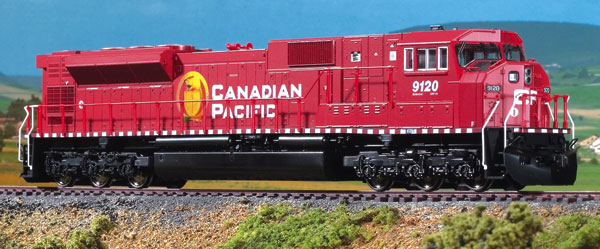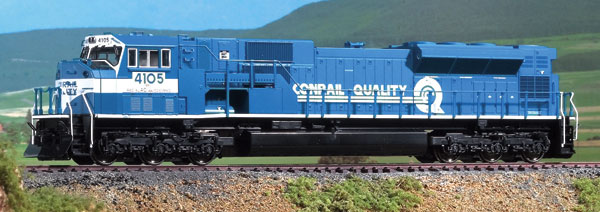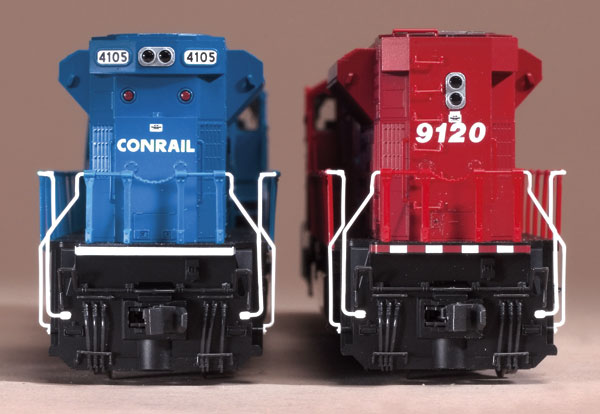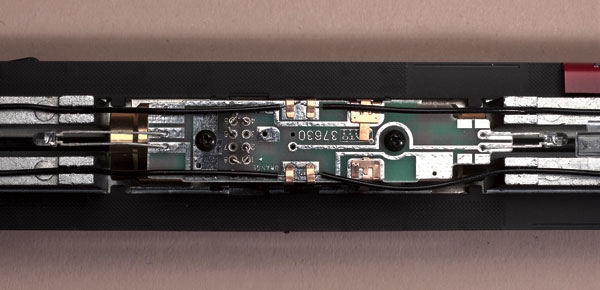With an overall length of 80′-2″, these Electro-Motive Division locomotives are huge compared to most other contemporary road diesels. Both locomotives share the same carbody, ride on six-wheel radial trucks, and weigh in at 420,000 pounds each.
A prototype plan and an article on the SD80MAC were published in the April 1997 Model Railroader. Both of these Kato models closely match this drawing. The MAC designation indicates the locomotive has a Modified North American cab and AC traction motors and electrical equipment. Most of these locomotives were built at EMD’s plant in London, Ontario.
- The SD80MAC is a 20-cylinder, 5,000-hp locomotive which was introduced with a pair of demonstrators in July 1995. Conrail was the only buyer, receiving 28 SD80MACs (nos. 4100-4127) in late 1995 and 1996. Conrail eventually bought the demonstrators, which became nos. 4128 and 4129.
- The SD9043MAC is an unusual 16-cylinder 4,300-hp locomotive that’s filling a pinch-hitting role. Introduced in October 1995, these units are being built with provisions for upgrading into the 6,000-hp SD90MAC-H locomotive as soon as EMD finishes development of the more powerful diesel engine. More than 400 SD9043MACs have been built to date for Canadian Pacific (61 units, 42 assembled at CP’s Ogden Shop in Calgary, Alberta), Union Pacific (309 units), and CIT Financial’s lease fleet (40 units).
Our sample models came partially assembled with about a dozen sprues of detail parts underneath the protective box insert. Most of these details are molded in colored acetal plastic so the parts mounted in exposed locations are flexible enough to prevent damage.
A four-page 8¼” x 11½” set of instructions includes exploded isometric drawings of the body and chassis assemblies. Additional diagrams identify the parts on the sprues and their locations on the body shells.
The only tools required are a small Phillips screwdriver, nippers to trim small parts off the sprues, and a pair of modeler’s pliers to gently press the detail parts into the holes. I tried using smooth-jaw pliers for this and found the slippery acetal parts tended to easily become airborne and disappear! With the serrated pliers, I could exert just enough pressure to hold the parts in the last couple of tip grooves without loss or damage. No cement is required, but I did use a drop of Walthers Goo to secure each bell.
The cabs have interiors and their clear window inserts include locking tabs that help secure the cab to the body shell. The running board and pilot assemblies feature “below deck” conduits and other visible details, including the upward kink behind the cabs.
A variety of tiny concealed latches lock the various body parts together. Small detail parts are press-fit into holes provided in the bodies. These items include numerous grab irons, m.u. hoses, snowplows, uncoupling levers, and windshield wipers.
The safety railings around the running boards are also molded in colored acetal plastic with a new twist. All of the vertical corner railings are molded in white plastic. They neatly press into sockets molded into the end stanchions of the side railings to provide the proper contrasting safety color.
Our sample locomotives performed flawlessly, producing identical results. Both started and ran steadily at an amazingly low 1.4 scale mph on 1 volt! The drawbar pull is equivalent to 60 free-rolling freight cars on straight and level track.
While the models will negotiate an 18″ minimum radius, their overhang will make it difficult to keep anything coupled to the locomotive. Larger curves (24″ and up) are recommended.
Kato knuckle couplers are mounted at the correct height in boxes attached to the metal chassis with small Phillips screws. These Kato couplers will couple with Kadees, but they lack uncoupling pins. Kadee no. 5 or similar couplers are easy to substitute.
Once again Kato has raised the bar on the detail and performance included in these models. With their flaring radiators, these current production, heavy-duty EMD road locomotives will be standouts on any contemporary model railroad.
Price: $149.98 each
Manufacturer:
Kato Inc.
100 Remington Rd.
Schaumburg, IL 60173
www.katousa.com
Description:
Plastic and metal locomotives
Features:
Cab interior
DCC socket
Drawbar pull: 4.32 ounces
Dual flywheel drive
Engine weight: 21 ounces
Kato knuckle couplers
Minimum radius: 18″ (without cars)
Six-axle drive and electrical pickup
White LED constant directional headlights and ditch lights
Road names:
SD80MAC:
Conrail (nos. 4103, 4105, and 4123)
Undecorated
SD9043MAC:
Canadian Pacific
(nos. 9120, 9122, and 9125)
Union Pacific (nos. 8038, 8039, 8059, 8104, 8105, and 8146)
Undecorated


















